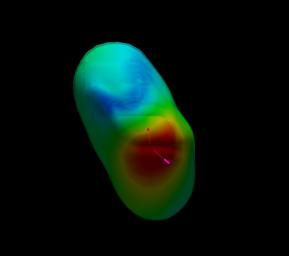
|
Our Solar System, from the Outside
- Click the image above for a larger view
- Full-Res JPEG (793 x 704) (17.7 kB)
- Full-Res TIFF (793 x 704) (1.7 MB)
Caption:
This graphic, based on data from NASA's Voyager spacecraft, shows a model of what our solar system looks like to an observer outside in interstellar space, watching our solar system fly towards the observer.
The colors map the intensity of the magnetic field around our solar system, with red indicating the highest intensity field and blue indicating the lowest intensity field. The thick red line shows the recent trajectory of Voyager 1. The thick magenta line shows the recent trajectory of Voyager 2. Tracing the trajectories farther back would show the location of our sun and the planets orbiting around it.
The motion of our solar system through the interstellar medium, or the space between stars, warps the magnetic bubble around our solar system. The interstellar magnetic field, which determines the orientation of the bubble around our solar system, is tilted relative to the plane of our planets. The plane of our planets is horizontal in this view.
Background Info:
The Voyagers were built by NASA's Jet Propulsion Laboratory in Pasadena, Calif., which continues to operate both spacecraft. JPL is a division of the California Institute of Technology in Pasadena. The Voyager missions are a part of the NASA Heliophysics System Observatory, sponsored by the Heliophysics Division of the Science Mission Directorate.
For more information about the Voyager spacecraft, visit http://www.nasa.gov/voyager and http://voyager.jpl.nasa.gov .
Cataloging Keywords:
| Name | Value | Additional Values |
|---|---|---|
| Target | Heliosphere | |
| System | Solar System | |
| Target Type | Heliosphere | |
| Mission | Voyager | |
| Instrument Host | Voyager 1 | Voyager 2 |
| Host Type | Flyby Spacecraft | |
| Instrument | ||
| Detector | ||
| Extra Keywords | Color, Magnetosphere, Map | |
| Acquisition Date | ||
| Release Date | 2011-04-28 | |
| Date in Caption | ||
| Image Credit | NASA/JPL/BU | |
| Source | photojournal.jpl.nasa.gov/catalog/PIA13899 | |
| Identifier | PIA13899 | |
